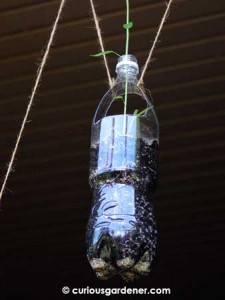I was trying to be environmentally conscious and decided to try to find ways to recycle used polyethylene terephthalate or PET soft drink bottles. Here are some of my “creative” solutions:

Young chives growing in a recycled bottle-pot.
PET bottle as a flower pot… This was my very first use of the recycled plastic bottle – to cut it in half and use the bottom as a flower pot. I like to experiment with different pot heights, and normally use the really short ones for germinating seeds in. Taller pots will house plants with deeper roots.

Young tomato plants in their SWCs.
PET bottle as a self-watering container… Great for plants that need lots of moisture, like mint, or for young plants. I use the screw cap that sits in the water as a water regulator – the looser it is, the more water enters; the tighter it is, the drier the soil will be. Of course, the trick is learning how much to tighten the cap. It varies, depending on the potting media, the amount of water in the reservoir below, and of course, the weather. The hotter the temperature, the faster the water is used up. But, at least your plants are not as much at the mercy of the heat.

Recycled bottle as a hanging flower pot.
PET bottle as a hanging flower pot… This was one of my more recent attempts. Using a strong cutter/blade, I created a pair of large holes near the top of the bottle where I wanted the plant to grow from. I also wanted to have room for a good amount of potting mix, so those holes had to be as high as possible. Using the tip of the blade, I poked small slits in the base of the bottle to allow excess water to drain from. To avoid loss of the small particles of potting mix, I put a thin layer of vermiculite right at the bottom first. So far, that seems to work. The final consideration was how to hang the bottles. My first idea was a noose around the bottle neck, but that would have allowed the bottle to swing too much. So I went with the idea of using two anchor points, through the holes for the plant to grow through instead of only around the bottle neck, for better stability. That works well. To jazz things up, you can tie a row of hanging bottles at different heights – and if you have any plants below, they will benefit from drip watering from the hanging pots!

Recycled bottle acting as a plant protector.
PET bottle as a young plant protector… I’ve been a little unlucky with my sunflower seedlings lately, and decided to go a little overboard when it came to planting them outside, especially the very young plants. The biggest danger to them would have been snails, so it seemed a perfect idea to isolate each in their own little “bubble”. I cut off the bottoms of the bottles, trying to retain some height to allow the plants to grow bigger. To further deter snails and other insects, I tied a small piece of netting to cover the top but still allow air to circulate. So far, no snails or insects have breached the protective “bubble”.
Of course, I also use the bottles as-is for my mixtures of liquid fertilizers, but that doesn’t really count as a “creative” solution, does it?
The next question that begs to be asked is how long I can continue to use these bottles before the plastic starts deteriorating and becomes a contaminant? I know that heat speeds up the deterioration, so those bottles that get full sun will have only one or two cycles before I finally put them in the recycle bin. That should be safe enough, and I will have used them beyond their original purpose. I feel good about that.
So, do you have any other ways of recycling bottles?
© 2010 curiousgardener.com All rights reserved.












